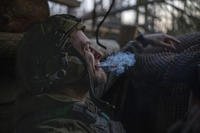Joseph V. Micallef is a best-selling military history and world affairs author, and keynote speaker. Follow him on Twitter @JosephVMicallef.
Russian state television broadcaster Rossiya 1, recently aired a news program that showcased the work of Russian president Vladimir Putin. The program features Russian current affairs as seen from the Kremlin's and Putin's perspective.
According to the Associated Press, "The first episode of "Moscow. Kremlin. Putin." aired on Sunday night (September 2), stressing the Russian president's work to address various crises and stay in touch with ordinary Russians."
Extensive Russian television coverage of Vladimir Putin is nothing new. Russia's state-controlled broadcast sector lavishes extensive coverage on the Russian president. During the recent Russian elections, Putin received more air time than all the other candidates combined.
Western media has taken to calling Vladimir Putin Russia's new tsar. Moscow scuttlebutt has it that behind his back, Kremlin staff routinely refer to Putin as "The Tsar." Is Putin acting like Russia's new tsar? More importantly, what does that tell us both about his leadership style and how Russian politics might evolve during and after Putin's reign?
The Origins of the Tsar
The first Russian monarch to claim the title of "Tsar" was Ivan IV (1530-1584). Tsar was a corruption of the Latin word Caesar, the title assumed by Roman emperors in classical antiquity. Ivan IV would go down in history with an additional moniker, Ivan the Terrible.
It was under Ivan IV that the Russian empire first took form. During his long reign, from 1553 to 1584, Russia undertook the conquest of the Khanates of Kazan, Astrakahn and Sibir. The latter would later give its name to Siberia--a vast, at the time unconquered, territory that stretched from the eastern flanks of the Ural Mountains to the shores of the western Pacific.
Under Ivan IV, the Grand Duchy of Moscow was transformed into a multi-ethnic, multi-continental state -- almost doubling in size to an area that spanned over 1.5 million square miles. From this process would emerge Russia and a Russian empire that, in its heyday, was the third largest in history, stretching from present day Poland to Alaska.
Ivan's designation of "the terrible" was well deserved. Although considered intelligent and devout, he was prone to uncontrollable fits of rage and periods of manic depression that got steadily worse as he got older.
In one outburst, he accidently killed his son and designated heir, Ivan Ivanovich.
Increasingly paranoid with age, in 1570 he ordered the death of many of the nobility of the city of Novgorod whom he suspected were plotting against him. The violent cruelty of the attack and the scale of the casualties made the incident the most brutal in the long, bloody history of Ivan's reign.
The term "terrible," however, has been mistranslated. To appreciate its significance, we must delve into Russia's perspective on the ideal character traits of a good tsar.
A Russian tsar was expected to have three qualities, described in Russian as batiushka, tishaishii and grozny.
Batiushka means literally "little father." The term, one of affection, was often applied to the reigning tsar as a term of endearment. The tsar was supposed to be like a little father to his people, expressing interest in their welfare and concern about their problems.
A common 19th century Russian expression among the downtrodden peasantry was the statement that, "if only the little father knew." In other words, if the tsar was made aware about a problem, it would quickly be set to right.
Throughout the history of Russian tsardom, the tsar was seen as a distant but caring figure, who any Russian could approach by way of a letter or a petition to bring an issue to his attention and, one presumes, a quick resolution.
In that sense, the tsar was separate from and the alternative to the indifference of a vast and uncaring bureaucracy that had little interest in the wellbeing of the average Russian. Indeed, it was only the compassion and benevolence of the tsar that could reign in an uncaring and, at times, malignant government.
The second trait that the tsar should demonstrate was tishaishii. The term means to be devout or pious. A tsar was expected to be more than just a supporter of the Russian Orthodox Church. He was also supposed to epitomize its teachings and practices, an example of devotion to be held out to the rest of the nation.
The tsar was not the leader of the Russian Church in the way that English monarchs are the titular heads of the Church of England. But they were tasked with defending, supporting and promoting it, and in return the Church was a stalwart supporter of the tsar, and of the Russian government, and a bedrock of Russian nationalism.
This subordination of the Russian Church to the Russian government, and their mutual support and association, has been a consistent feature of Russian state-church relations ever since the Metropolitan of Kiev moved to Moscow in 1325. So, too, has been the integral role that the Russian Orthodox Church has played in promoting and justifying Russian nationalism.
In 1853, for example, the Russian Tsar Nicholas I used a dispute between the Russian Orthodox prelate in Jerusalem and his Catholic counterpart over who would control access to Christian holy places in Jerusalem, and in particular who would possess the keys to the Church of the Nativity, to declare war on the Ottoman Empire -- a conflict that would precipitate the Crimean War (1853-1856).
The dispute had been triggered by the machinations of French Emperor Napoleon III to enhance the status of the Roman Catholic Church as the overseer of Christian holy sites in the Ottoman Empire in order to curry political support from conservative French Catholics.
The mutual support has worked in both directions. The Russian Orthodox Church, for example, praised the Russian takeover of Crimea as a return of the Crimean faithful from the Ukrainian Orthodox Church, which it described as corrupt and heretical, to the Russian one.
This close, historic association between the Russian Orthodox religion and the Russian government is underscored by the fact that the recent leadership of the Russian church all have strong links to the Russian intelligence service. The current leader of the Russian Orthodox Church, Patriarch Kirill (Vladimir M. Gundyaev), is a former intelligence officer with the Soviet KGB. So too was his predecessor Alexy II.
The third aspect of a tsar's character was grozny. The term grozny is typically interpreted as "terrible," as in Ivan Grozny or Ivan the Terrible. Today the word terrible is employed as a pejorative term. There is another, now archaic, meaning for terrible: larger than life, imposing, awe inspiring.
The moniker grozny applied to Ivan IV was not describing his brutality or his rages, but rather the fact that he was an imposing, larger than life character.
These three qualities, batiushka, tishaishii and grozny described the ideal character of a tsar. They are equally adept at describing the public persona of Russian President Vladimir Putin.
Vladimir the Great: The Good Tsar
In his public persona, Vladimir Putin has gone to great lengths to epitomize the three ideal character traits of batiushka, tishaishii and grozny that were supposed to epitomize a good tsar.
Putin is, like the tsars of old, "a little father" who makes a point of listening and becoming involved in the problems of his people. He is well known for his multi-hour marathons on Russian television where ordinary Russian are invited to call in and be able to "ask Vladimir Putin anything."
Invariably, most of the calls involve ordinary Russian citizens telling Putin about one problem or another of dealing with the Russian government's vast, indifferent bureaucracy. Just like the tsars of old, the presumption is that if the "little father" Putin was made aware of a problem he would quickly set it right.
On the television program, Putin appears with a laptop, where he diligently makes notes about the issue, asking the caller for their contact information so he can have someone follow up.
The same theme was underscored in the new, hour-long Rossiya I program. Emphasizing his common touch, Putin's spokesman Dmitry Peskov declared that, "Putin loves not only children, he loves people in general. He's a very humane person."
Putin often presents himself as being separate from the Russian government; as being somehow both above it and also the only person who can tame and control it. The distinction has often allowed him to deflect criticism for unpopular government policies onto the state bureaucracy, rather than being held personally responsible.
Vladimir Putin has also underscored his tishaishii by his public dealings with the Russian Orthodox Church. He has received strong support from the Russian Orthodox Church. In turn, he has also been a strong supporter of the church, funding it to the tune of hundreds of millions of rubles and embarking on an extensive campaign to restore historic churches. He is frequently photographed attending church services or visiting Orthodox holy sites.
The Kremlin has often used the iconography of Orthodox saints and martyrs in its own propaganda and nationalist efforts. For example, one of the new self-described "super weapons" that Putin unveiled in March 2018, is a short-range, directed-energy weapon (laser cannon) for anti-missile defense called Peresvet. It is named for a 14th century warrior monk, Alexander Peresvet, venerated in the Russian Orthodox Church as a saint and martyr for his role in a battle against the Mongols.
Putin also embodies the character of grozny, a large than life, imposing, awe-inspiring person. This is after all a Russian leader who has himself filmed riding bare-chested and bareback across the Russian steppe, wrestling with bears, showing off his black belt karate skills and engaging in daring and dangerous acts that would, one presumes, frighten lesser morals.
It's hard to imagine an American president's Secret Service detail allowing their ward to engage in acts that would normally be reserved for a stuntman.
This character of grozny is also reflected in the image that Putin projects in his dealings with foreign leaders, especially in the way such encounters are reported on Russian television. Such meetings are invariably portrayed as a test of wills, with Putin besting his "opponent" and forcing them to conform to Russia's demands. Admittedly, this doesn't always play very convincingly, even in the shameless propaganda that now passes for Russian news broadcasts.
The sanctions imposed on Russia because of its seizure of the Crimea, for example, are invariably presented as a standoff, with Russian imposed sanctions portrayed as being equally punishing on Russia's opponents and precipitating diplomatic requests from Europe and the United States that they be eased.
Putin As Tsar: An Assessment
In showcasing the character of batiushka, tishaishii and grozny, Vladimir Putin is simply demonstrating those characteristics that Russians have historically looked for in their leaders. Such characteristics are not inherently anti-democratic, but they go hand in hand with a strong, centralizing government and the concentration of power that characterizes it makes such anti-democratic outcomes more likely.
Russian history has underscored the fact that Russian stability and prosperity have typically been associated with strong, centralizing governments and strong leaders. It's not so much a case that Putin is acting like a Russian tsar, as it is a case that both tsars and modern Russian presidents have found the three characteristics of batiushka, tishaishii and grozny a useful addition to their public persona.
There has been a tendency in the West to try to draw distinctions between Russian "moderates," i.e., "reformers" like Prime Minister Dmitry Medvedev, and the former KGB molded "hardliners" like Vladimir Putin. There is little doubt that Putin revels in the grozny character of Russian leadership but looking for the distinction between Russian "moderates" and "hardliners" may prove to be a meaningless exercise.
Vladimir Putin may be a child of the KGB, but he is also a son of Mother Russia, and he has an uncanny knack for knowing what characteristics Russians want to see in their leaders. There will always be "moderates" and "hardliners" in the Russian government, but regardless who follows Putin, admittedly a theoretical question since he shows no interest in stepping down anytime soon, that leader will be more likely than not to reflect that character of batiushka, tishaishii and grozny so closely identified with Russian tsardom and now with Vladimir Putin.
-- The opinions expressed in this op-ed are those of the author and do not necessarily reflect the views of Military.com. If you would like to submit your own commentary, please send your article to opinions@military.com for consideration.















